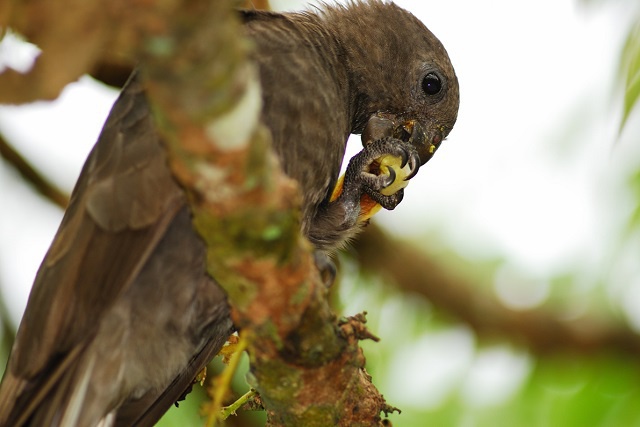British researcher's genetic study highlights urgency of saving endemic Seychelles Black Parrot
(Seychelles News Agency) - The Seychelles Black Parrot is one of the Indian Ocean archipelago’s thirteen endemic bird species, a status it achieved early last year after being recognised as a distinct species, Coracopsis barklyi, by taxonomic experts.
The recognition, which came after some five years of intensive research confirmed that the Seychelles bird is different from other parrot species found in neighbouring Indian Ocean islands thus needing greater conservation.
The Seychelles Black Parrot, which is part of a small group of parrots (Coracopsis sp.) found only in the Western Indian Ocean, was previously considered a sub-species of the Lesser Vasa Parrot (Coracopsis nigra), with three other sub-species occurring in Madagascar and the Comoros.
The need to conserve the bird, the current population of which is estimated to be between 520 to 900 has now been further reinforced with the availability of more research on the evolutionary history of the species.
A researcher from the Durrell Institute of Conservation and Ecology (DICE) in the UK, Hazel Jackson, has used DNA techniques to analyse blood samples as well as the measurement of birds' wings and beaks. She has now been able to confirm that there really is a distinct difference between the Seychelles Black Parrot and other parrot species found in the Comoros and Madagascar.
“…if it would have been exactly the same as Comoros and Madagascar it wouldn’t have been as important to conserve it because you could argue the identical species were on different islands. However we’ve shown it’s a unique species only found on Praslin, so it’s very important that we conserve that particular species,” said Jackson who recently presented the outcome of his research to interested parties in Seychelles.
To trace the evolutionary history of the Seychelles Black Parrot over the last eight million years, Jackson analysed some 80 samples taken from the Seychelles birds as well as the other sub-species in the Comoros and Madagascar which she compared with samples available in several museums in the UK.
While her research will help to understand the evolutionary history of the Black Parrot and how genetically healthy the population is now, Jackson noted that to continue conservation of the species it is really important that further genetic studies are done in the future.
The entire Seychelles Black Parrot population of between 500 to 900 birds is found only on the Seychelles second most populated island of Praslin.
Of these, it is estimated that around a 100 hundred of the endemic birds live in the similarly vulnerable endemic coco-de-mer palm forest of the Vallée de Mai. The UNESCO World Heritage site is managed by the Seychelles Island Foundation, SIF, a public trust established in 1979.
During her recent presentation, Jackson also noted that the bird's single-island distribution renders the species highly vulnerable to factors such as forest fires, disease outbreaks and climate change.
The Black Parrot, which is listed as vulnerable on the Red List of the International Union for Conservation of Nature (IUCN), is also threatened by other invasive bird species including the Indian Mynah and the Ring-Necked Parakeet.
A project to eradicate the very destructive ring-necked parakeets on the Seychelles main island of Mahé and constant monitoring to confirm reports of sporadic sightings on Praslin since September 2014 are also ongoing as part of efforts to eliminate the threat.
Conservationists are however hopeful that the national bird of the Indian Ocean island nation is making tiny but encouraging strides as they closely follow the current breeding season.
Terence Payet, one of three Seychellois conservation officers actively working to monitor the population of the bird, told SNA that since the onset of the breeding season in November last year they have located a total of 25 nests and 51 eggs, which have hatched 14 chicks thus far.
SIF's senior conversation officer, Wilna Accouche, says this makes the breeding season to date successful, in relation to previous ones while noting that information gathered throughout the breeding period will be available and analysed after the close of the season in April.
While conservation officers work tirelessly to protect the Seychelles Black Parrot, SIF is certain that the result of Jackson's research will help the Indian Ocean archipelago in its drive to secure more funding to continue safeguarding the vulnerable endemic species.
SIF has also started discussions with several partners to explore the possibility of relocating the bird in a new habitat as one of its future conservation efforts - something which has been done with varying levels of success with other bird species like the Seychelles Warbler, the Seychelles Magpie Robin and the Seychelles White-eye or 'Zwazo Linet' as it is known in the native Creole language.
For now though, the option is still in the discussion phase as such a move would have to ensure that the necessary conditions including the availability of food to allow the survival of the species are taken into consideration.






